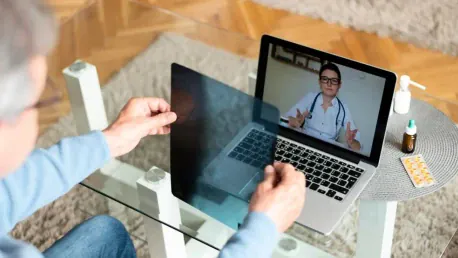Remote monitoring has emerged as a transformative approach in healthcare, particularly for managing chronic conditions like heart failure (HF) and chronic obstructive pulmonary disease (COPD). Hamilton Health Sciences (HHS) in Canada has recently launched an innovative remote symptom monitoring program aimed at enhancing patient care and outcomes for individuals living with these conditions. This article explores the various facets of this pioneering initiative and its potential impact on healthcare delivery.
The Innovative Approach to Remote Monitoring
Introduction of the Program
Hamilton Health Sciences has taken a significant step forward by introducing a remote symptom monitoring program for HF and COPD patients. This initiative is designed to allow patients to be monitored from the comfort of their homes, thereby improving their overall health outcomes. The program leverages advanced technology to provide continuous care and early intervention, which is crucial for managing chronic conditions effectively. This transformative initiative is not just an innovation in technology but also a new paradigm in patient care designed to bring effective healthcare to the home setting.
Additionally, the program has been structured to ensure that patients feel connected and supported throughout their medical journey. By monitoring patients remotely, the program not only reduces logistical challenges but also addresses the critical need for timely medical interventions. This approach helps mitigate the risks associated with HF and COPD, significantly lowering the chances of acute exacerbations that can lead to emergency room visits and hospitalizations.
Integration with MyChart and Epic
The program is integrated with MyChart Care Companion, a feature within the globally recognized Epic hospital information system. MyChart enables patients to access their health information, including lab results, appointment details, and doctors’ notes, through various devices such as computers, tablets, and mobile phones. This integration ensures that patients have real-time access to their health data, facilitating better self-management and communication with healthcare providers. The seamless integration of MyChart with Epic makes it possible for healthcare providers to receive up-to-date information, enabling them to provide timely and effective interventions.
Moreover, MyChart’s user-friendly interface empowers patients to take an active role in managing their health. Patients can easily track their symptoms, set reminders for medication, and communicate with their healthcare team, enhancing their engagement and adherence to treatment plans. This seamless connectivity not only makes healthcare more accessible but also fosters a collaborative relationship between patients and providers, thereby improving the overall quality of care.
Customized Monitoring Protocols
Development of Protocols
HHS has developed customized remote monitoring protocols specifically for HF and COPD patients. These protocols were created with the expertise of HHS clinical informatics teams, clinical experts, and operational leaders. The tailored approach ensures that the monitoring is relevant and effective for the specific needs of these patients, addressing the unique challenges associated with managing HF and COPD. This meticulous customization is pivotal in ensuring that patients receive care tailored to their individual health requirements and conditions.
The protocols encompass a range of metrics and health indicators that are crucial in managing HF and COPD. By establishing these specific protocols, HHS ensures that the remote monitoring system captures essential data points necessary for providing timely medical interventions. This structured approach guarantees that all critical aspects of a patient’s condition are monitored, leading to more accurate and effective management of their health.
Implementation and Monitoring
Patients are monitored by HHS virtual care nurses and nurse practitioners using care pathways integrated into Epic. This allows for early intervention and potentially prevents the worsening of HF and COPD conditions. By closely monitoring patients’ symptoms and vital signs, healthcare providers can take timely actions to address any issues, thereby reducing emergency department visits and hospital readmissions. The continuous monitoring provides a safety net, ensuring that any deviations from normal health patterns are immediately identified and addressed.
The system’s ability to generate real-time alerts allows healthcare teams to act swiftly, thereby minimizing the chances of complications. This proactive approach not only enhances patient outcomes but also optimizes healthcare resources by reducing the need for hospital admissions. The reduction in hospital visits translates into cost savings and more efficient use of healthcare facilities, ultimately benefiting the health system as a whole.
Efficiency and Cost Savings
Provision of Home Monitoring Kits
One of the key aspects of the program is the provision of home monitoring kits to patients. These kits include devices such as iPads, blood pressure cuffs, weight scales, pulse oximeters, and thermometers. By supplying these hospital-owned devices, HHS eliminates the need for patients to rent equipment from external providers, ensuring that all patients have access to the necessary technology for effective monitoring. This provision levels the playing field, as all patients, regardless of their socio-economic status, have access to high-quality monitoring tools.
The availability of these monitoring kits facilitates continuous and accurate tracking of vital signs and symptoms, enhancing the overall effectiveness of the program. Patients can effortlessly use these devices to monitor their health, input data, and communicate with their healthcare team. This ensures the timeliness and accuracy of health information, which is critical for effective remote monitoring and timely medical interventions.
Streamlined Data Collection
The integration of these devices within the Epic system facilitates seamless data collection, eliminating the need for manual data entries by nurses. This streamlining of the process not only enhances efficiency but also reduces the likelihood of errors, ensuring that healthcare providers have accurate and up-to-date information to make informed decisions about patient care. The automation of data collection ensures that health records are continuously updated with the latest patient information, promoting more accurate and timely care.
Moreover, the efficient data management system enables healthcare providers to quickly access and analyze patient data, leading to faster and more precise medical response. This technological advancement transforms the traditionally time-consuming process of data entry and analysis into a streamlined system, allowing healthcare professionals to focus more on patient care and less on administrative tasks. This shift significantly enhances the overall provider experience and patient outcomes.
Positive Implications for Patient and Provider Experience
Improved Patient Care
The remote symptom monitoring program aims to improve the health outcomes and well-being of patients by providing continuous and proactive care. Patients can recover in the comfort of their homes while being closely monitored by healthcare professionals. This approach not only enhances patient satisfaction but also contributes to better health outcomes by enabling early intervention and timely support. Keeping patients at home while still under medical supervision can significantly enhance their comfort and reduce the stress associated with frequent hospital visits.
Furthermore, the personalized and responsive nature of remote monitoring ensures that patients feel supported and cared for at all times. This reduces anxiety and increases adherence to treatment plans, as patients know that their health is being consistently monitored. The continuous oversight by healthcare professionals allows for early detection and management of any health issues, preventing complications and hospital readmissions.
Enhanced Provider Experience
For healthcare providers, the program offers significant benefits by reducing manual tasks and creating efficient workflows. The integration of workflows within Epic improves work efficiency and satisfaction for HHS virtual nursing staff and other team members. By focusing on patient care rather than administrative tasks, providers can deliver higher quality care and achieve better patient outcomes. This advancement empowers healthcare providers to allocate more time to patient interactions, care planning, and clinical decision-making.
Additionally, the streamlined data collection and management systems transform the conventional hectic workload into a more manageable and efficient process. Providers can easily access patient data, analyze trends, and make more informed medical decisions without the burden of manual data input. This fosters a more satisfying work environment, enhances job satisfaction, and ultimately leads to improved patient care.
Potential for Expansion and Broader Impact
Expansion to Other Health Conditions
If the remote symptom monitoring program proves successful for HF and COPD patients, there is potential for expansion to include patients with other health conditions. The clinical pathways and protocols developed by HHS can be shared with other Epic hospitals across Canada, fostering a collaborative approach to improving patient care and health system outcomes on a broader scale. This potential expansion highlights the program’s adaptability and its capability to address a wide range of medical conditions effectively.
The adoption of these clinical pathways by other hospitals can lead to a standardization of high-quality remote monitoring practices nationwide. As more health conditions are included, the program can potentially revolutionize chronic disease management across the country. This exemplifies the scalability of remote monitoring solutions and their significant potential to elevate healthcare standards universally.
Inspiration and Future Prospects
Remote monitoring has become a groundbreaking method in healthcare, significantly benefiting the management of chronic conditions such as heart failure (HF) and chronic obstructive pulmonary disease (COPD). Hamilton Health Sciences (HHS) in Canada has introduced a pioneering remote symptom monitoring program designed to improve patient care and outcomes for those living with these conditions. This initiative integrates advanced technology to track patients’ symptoms and provide timely medical interventions. By leveraging remote monitoring, healthcare providers can offer more personalized care, potentially reducing hospital readmissions and improving the overall quality of life for patients. The program at HHS highlights the crucial role of technology in transforming chronic disease management and showcases how remote monitoring can lead to more efficient and effective healthcare delivery. This article delves into the various aspects of this innovative program and examines its potential to revolutionize the way we approach chronic disease care.









